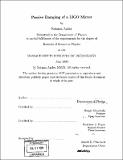Passive damping of a LIGO mirror
Author(s)
Antler, Natania
DownloadFull printable version (38.11Mb)
Alternative title
Passive damping of a Laser Interferometer Gravitational-Wave Observatory mirror.
Other Contributors
Massachusetts Institute of Technology. Dept. of Physics.
Advisor
Nergis Mavalvala.
Terms of use
Metadata
Show full item recordAbstract
There may be largely untapped source of information about our cosmic surroundings in the form of gravitational radiation, predicted by Einstein's theory of General Relativity. If detected, gravitational waves (GWs) could become a valuable means to study astrophysical events. The Laser Interferometer Gravitational-Wave Observatory (LIGO) has built detectors to search for these GWs. In essence, these detectors are several kilometer long Michelson interferometers with Fabry-Perot cavities in the arms. In order to detect gravitational waves, LIGO must be sensitive to relative displacements on the order of 10-18 m. Advanced LIGO, a detector upgrade, is projected to achieve a tenfold increase in sensitivity through a wide range of new technologies and techniques. One proposed change is to increase the laser power in the cavities from ~10 W to ~180 W. There is concern that with this increased radiation pressure, optical modes in the cavity may overlap with acoustic modes of the mirrors and excite mechanical motion. If such a parametric instability occurs, it will disrupt the operation of the interferometer. In this thesis I test a method to passively damp the acoustic modes of the mirror, using a mass-spring damper. The damper can be modeled as a piezoelectric "spring" (PZT) connected to a seismic mass. The damper can lose energy from both mechanical motion, and motion of charge through a resistor across the PZT. (cont.) I built a small Michelson interferometer to measure the acoustic modes of an Initial LIGO mirror, excited by an electrostatic drive, while it hung as a pendulum in vacuum. For a 6.6 kHz mode of the mirror, I found that the quality factor, or Q, of the mirror decreased from (7.7 ± 0.1) x 105 to (6.2 ± 0.1) x 103 when the damper was added. The addition of a resistor across the PZT reduced the Q below the measurement threshold.
Description
Thesis (S.B.)--Massachusetts Institute of Technology, Dept. of Physics, 2009. Includes bibliographical references (p. 75-76).
Date issued
2009Department
Massachusetts Institute of Technology. Department of PhysicsPublisher
Massachusetts Institute of Technology
Keywords
Physics.